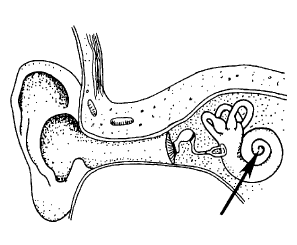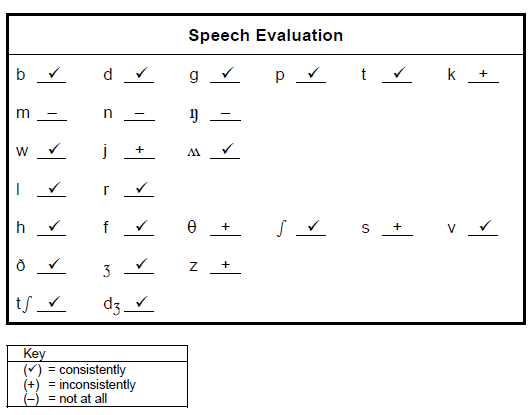Study Guide
Sample Selected-Response Questions
Field 26: Special Education: Hearing Impaired
Practice Questions
Subarea I–Understanding Students Who Are Deaf or Hard of Hearing
Objective 0002: Understand processes involved in hearing and characteristics of all types and degrees of hearing loss.
1. Use the diagram below to answer the question that follows.

In this diagram, which of the following structures is indicated by the arrow?
- eardrum
- stapes
- hammer
- cochlea
- Enter to expand or collapse answer. Answer expanded
- Correct Response: D.
Objective 0003: Understand language (including oral, written, and sign language) and language development.
2. Which of the following manual communication systems makes the greatest use of facial expression, posture, movement, and space?
- cued speech
- Signed English
- American Sign Language
- finger spelling
- Enter to expand or collapse answer. Answer expanded
- Correct Response: C.
Subarea II–Assessing Students and Developing Individualized Education Programs (IEPs)
Objective 0005: Understand assessment procedures for evaluating individual differences and making placement and programming decisions for students with disabilities.
3. Which of the following types of information would be useful for determining the reliability of a formal assessment instrument?
- A panel of content experts has indicated that questions on the test are accurate and significant.
- Students who take the test more than once receive similar scores each time.
- Students who score high on the test also score high on other standardized tests.
- The test scores of students from a variety of backgrounds are evenly distributed across the range of scores.
- Enter to expand or collapse answer. Answer expanded
- Correct Response: B.
Objective 0006: Interpret assessment results related to students' auditory functioning.
4. In diagnosing a hearing loss, a bone-conduction test is primarily used to measure which of the following?
- level of hearing in the inner ear
- automatic reflexes within the ear
- behavioral responses to auditory stimuli
- functioning of the middle ear
- Enter to expand or collapse answer. Answer expanded
- Correct Response: A.
Objective 0008: Understand procedures for assessing speech in students who are deaf or hard of hearing.
5. Use the student speech assessment data below to answer the question that follows.

The key indicates that a checkmark means the student produces the sound consistently, a plus sign means the student produces the sound inconsistently, and a minus sign means the student produces the sound not at all. I will now read the list.
B, checkmark.
D, checkmark.
G, checkmark.
P, checkmark.
T, checkmark.
K, plus sign.
M, minus sign.
N, minus sign.
Eng, minus sign.
W, checkmark.
J, plus sign.
Upside-down W, checkmark.
L, checkmark.
R, checkmark.
H, checkmark.
F, checkmark.
Theta, plus sign.
Esh, checkmark.
S, plus sign.
V, checkmark.
Eth, checkmark.
Ezh, checkmark.
Z, plus sign.
T esh, checkmark.
D ezh, checkmark.
According to these assessment data, the student is experiencing most difficulty with which type of consonants?
- liquids
- nasals
- plosives
- semivowels
- Enter to expand or collapse answer. Answer expanded
- Correct Response: B.
Objective 0010: Apply procedures for developing and implementing Individualized Education Programs (IEPs) for students who are deaf or hard of hearing.
6. The IEP of a student with a hearing impairment and special education needs must include:
- evidence from research findings documenting the appropriateness of approaches selected for use.
- lesson plans to meet stated IEP objectives.
- a summary of projected annual costs and staff hours required for implementing the IEP.
- annual goals for the student's individualized program.
- Enter to expand or collapse answer. Answer expanded
- Correct Response: D.
Subarea III–Promoting Student Development and Learning
Objective 0012: Understand amplification methods and strategies for promoting auditory skill development in students who are deaf or hard of hearing.
7. Which of the following is an appropriate procedure for the regular maintenance and monitoring of a hearing aid?
- Wash each hearing component using a mild cleaning solution.
- Check the batteries in the hearing aid each day using a battery tester.
- Hold the hearing aid close to the ear to check for feedback.
- Replace the earmold of the hearing aid at least once a month.
- Enter to expand or collapse answer. Answer expanded
- Correct Response: B.
Objective 0013: Understand how to promote language development in students who are deaf or hard of hearing.
8. Parents/guardians could best help a child who is deaf or hard of hearing improve his or her language skills by doing which of the following?
- having the child sign age-appropriate materials while reading
- reviewing each day's language lessons with the child after school
- organizing family activities that expose the child to new experiences
- having the child repeat phrases and sentences signed by other family members
- Enter to expand or collapse answer. Answer expanded
- Correct Response: C.
Objective 0014: Understand how to promote speech development in students who are deaf or hard of hearing.
9. A student with a hearing impairment emits excessive breath when pronouncing the letter h. Which of the following is a visual medium that would be especially helpful in addressing this problem?
- a paper strip placed in front of the face
- a mirror
- a light activated by a microphone
- a Visi-Pitch machine
- Enter to expand or collapse answer. Answer expanded
- Correct Response: A.
Objective 0015: Understand how to meet the overall communication needs of students who are deaf or hard of hearing.
10. The family of a toddler who is deaf uses American Sign Language as its native language in the home. The parents ask a teacher of the deaf and hard of hearing how their child's language development is likely to compare, in sequence and rate, to that of hearing toddlers. Which of the following is the best response to this question?
- The acquisition of sign language parallels the acquisition of spoken language because the same linguistic principles apply to both languages.
- Because the two languages differ fundamentally in syntax and structure, they cannot be acquired at the same rate.
- The acquisition of sign language is somewhat delayed in comparison to the acquisition of spoken language because signing is acquired like a second language.
- Because the two languages are similar in syntax and structure, they are acquired at about the same rate and according to the same sequence.
- Enter to expand or collapse answer. Answer expanded
- Correct Response: A.
Subarea IV–Working in a Collaborative Learning Community
Objective 0019: Understand how to promote strong school-home relationships.
11. A special education teacher wants to help the parents/guardians of students who are deaf or hard of hearing gain a better understanding of the special needs of their children. The teacher could meet this objective most effectively by organizing a series of parent/guardian workshops that focus on which of the following topics?
- the etiology of types of hearing impairments
- procedural requirements related to the development of IEPs for students who are deaf or hard of hearing
- the interpretation of student hearing assessment results
- instructional techniques for students who are deaf or hard of hearing that can be applied in a variety of settings
- Enter to expand or collapse answer. Answer expanded
- Correct Response: D.
Objective 0022: Understand the history and philosophy of special education, key issues and trends, roles and responsibilities, and legal and ethical issues relevant to special education.
12. Beginning in the 1970s, widespread dissatisfaction with oralism as an instructional approach led most educational institutions for deaf students in the United States to adopt methods characterized by:
- increased emphasis on fingerspelling.
- concentration on the development of auditory skills in preference to lip reading.
- development of a total communication approach.
- replacement of instruction in oral skills with instruction in sign language.
- Enter to expand or collapse answer. Answer expanded
- Correct Response: C.